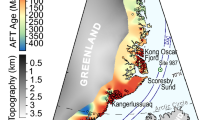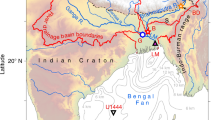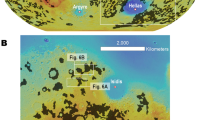Abstract
The alpine topography observed in many mountainous regions is thought to have formed during repeated glaciations of the Quaternary period1,2. Before this time, landscapes had much less relief1,2,3. However, the spatial patterns and rates of Quaternary exhumation at high latitudes—where cold-based glaciers may protect rather than erode landscapes—are not fully quantified. Here we determine the exposure and burial histories of rock samples from eight summits of steep alpine peaks in northwestern Svalbard (79.5° N) using analyses of 10Be and 26Al concentrations4,5. We find that the summits have been preserved for at least the past one million years. The antiquity of Svalbard’s alpine landscape is supported by the preservation of sediments older than one million years along a fjord valley6, which suggests that both mountain summits and low-elevation landscapes experienced very low erosion rates over the past million years. Our findings support the establishment of northwestern Svalbard’s alpine topography during the early Quaternary. We suggest that, as the Quaternary ice age progressed, glacial erosion in the Arctic became inefficient and confined to ice streams, and high-relief alpine landscapes were preserved by minimally erosive glacier armour.
This is a preview of subscription content, access via your institution
Access options
Subscribe to this journal
Receive 12 print issues and online access
$259.00 per year
only $21.58 per issue
Buy this article
- Purchase on Springer Link
- Instant access to full article PDF
Prices may be subject to local taxes which are calculated during checkout




Similar content being viewed by others
References
Montgomery, D. R. Valley formation by fluvial and glacial erosion. Geology 30, 1047–1050 (2002).
Norton, K. P., Abbuehl, L. M. & Schlunegger, F. Glacial conditioning as an erosional driving force in the Central Alps. Geology 38, 655–658 (2010).
Kleman, J. & Stroeven, A. P. Preglacial surface remnants and Quaternary glacial regimes in northwestern Sweden. Geomorphology 19, 35–54 (1997).
Balco, G., Stone, J. O., Lifton, N. A. & Dunai, T. J. A complete and easily accessible means of calculating surface exposure ages or erosion rates from 10Be and 26Al measurements. Quat. Geochronol. 3, 174–195 (2008).
Bierman, P. R., Marsella, K. A., Patterson, C., Davis, P. T. & Caffee, M. Mid-Pleistocene cosmogenic minimum-age limits for pre-Wisconsinan glacial surfaces in southwestern Minnesota and southern Baffin island: A multiple nuclide approach. Geomorphology 27, 25–39 (1999).
Houmark-Nielsen, M. & Funder, S. Pleistocene stratigraphy of Kongsfjordhallet, Spitsbergen, Svalbard. Polar Res. 18, 39–49 (1999).
Hallet, B., Hunter, L. & Bogen, J. Rates of erosion and sediment evacuation by glaciers: A review of field data and their implications. Glob. Planet. Change 12, 213–235 (1996).
Mitchell, S. G. & Montgomery, D. R. Influence of a glacial buzzsaw on the height and morphology of the Cascade Range in central Washington State, USA. Quat. Res. 65, 96–107 (2006).
Egholm, D. L., Nielsen, S. B., Pedersen, V. K. & Lesemann, J. E. Glacial effects limiting mountain height. Nature 460, 884–887 (2009).
Mills, J. E. Stratigraphy and succession of the rocks of the Sierra Nevada of California. Geol. Soc. Am. 3, 413–444 (1892).
Hall, A. M. & Kleman, J. Glacial and periglacial buzzsaws: Fitting mechanisms to metaphors. Quat. Res. 81, 189–192 (2014).
Hall, A. M. & Sugden, D. E. Limited modification of mid-latitude landscapes by ice sheets: The case of northeast Scotland. Earth Surf. Process. Landf. 12, 531–542 (1987).
Kleman, J. Preservation of landforms under ice-sheets and ice caps. Geomorphology 9, 19–32 (1994).
Thomson, S. N. et al. Glaciation as a destructive and constructive control on mountain building. Nature 467, 313–317 (2010).
Jakobsson, M. et al. Arctic Ocean glacial history. Quat. Sci. Rev. 92, 40–67 (2014).
Landvik, J. Y. et al. Landscape imprints of changing glacial regimes during ice-sheet build-up and decay: A conceptual model from Svalbard. Quat. Sci. Rev. 92, 258–268 (2014).
Gjermundsen, E. F. et al. Late Weichselian local ice dome configuration and chronology in Northwestern Svalbard: Early thinning, late retreat. Quat. Sci. Rev. 72, 112–127 (2013).
Landvik, J. Y. et al. Northwest Svalbard during the last glaciation: Ice-free areas existed. Geology 31, 905–908 (2003).
Fabel, D. et al. Landscape preservations under Fennoscandian ice sheets determined from in situ produced 10Be and 26Al. Earth Planet. Sci. Lett. 201, 397–406 (2002).
Glasser, N. F., Hughes, P. D., Fenton, C., Schnabel, C. & Rother, H. 10Be and 26Al exposure-age dating of bedrock surfaces on the Aran ridge, Wales: Evidence for a thick Welsh Ice Cap at the Last Glacial Maximum. J. Quat. Sci. 27, 97–104 (2012).
Stroeven, A. P., Fabel, D., Hattestrand, C. & Harbor, J. A relict landscape in the centre of Fennoscandian glaciation: Cosmogenic radionuclide evidence of tors preserved through multiple glacial cycles. Geomorphology 44, 145–154 (2002).
Nansen, F. The Strandflat and Isostasy (Vitenskapsselskapets Skrifter I. Matematisk-Naturvitenskapelig Klasse No. II) 1–313 (A. W. Brøggers Boktrykkeri, 1922).
Sugden, D. E. Glacier erosion by the Laurentide Ice Sheet. J. Glaciol. 20, 367–391 (1978).
Solheim, A., Andersen, E. S., Elverhøi, A. & Fiedler, A. Late Cenozoic depositional history of the western Svalbard continental shelf, controlled by subsidence and climate. Glob. Planet. Change 12, 135–148 (1996).
Etzelmüller, B. & Frauenfelder, R. Factors controlling the distribution of mountain permafrost in the northern hemisphere and their influence on sediment transfer. Arctic Antarct. Alpine Res. 41, 48–58 (2009).
Raymo, M. E., Lisiecki, L. E. & Nisancioglu, K. H. Plio-Pleistocene ice volume, Antarctic climate, and the global δ18O record. Science 313, 492–495 (2006).
Brook, E. J., Nesje, A., Lehman, S., Raisbeck, G. & Yiou, F. Cosmogenic nuclide exposure ages along a vertical transect in western Norway: Implications for the height of the Fennoscandian ice sheet. Geology 24, 207–210 (1996).
Darmody, R. G. et al. Age and weathering status of granite tors in Arctic Finland (similar to 68 degrees N). Geomorphology 94, 10–23 (2008).
Fabel, D. et al. Landscape preservations under Fennoscandian ice sheets determined from in situ produced 10Be and 26Al. Earth Planet. Sci. Lett. 201, 397–406 (2002).
Harbor, J. et al. Cosmogenic nuclide evidence for minimal erosion across two subglacial sliding boundaries of the late glacial Fennoscandian ice sheet. Geomorphology 75, 90–99 (2006).
Håkansson, L. et al. Late Pleistocene glacial history of Jameson Land, central East Greenland, derived from cosmogenic 10Be and 26Al exposure dating. Boreas 38, 244–260 (2009).
Li, Y., Fabel, D., Stroeven, A. P. & Harbor, J. Unraveling complex exposure-burial histories of bedrock surfaces under ice sheets by integrating cosmogenic nuclide concentrations with climate proxy records. Geomorphology 99, 139–149 (2008).
Roberts, D. H., Long, A. J., Schnabel, C., Freeman, S. & Simpson, M. J. R. The deglacial history of southeast sector of the Greenland Ice Sheet during the Last Glacial Maximum. Quat. Sci. Rev. 27, 1505–1516 (2008).
Stone, J. O., Ballantyne, C. K. & Fifield, L. K. Exposure dating and validation of periglacial weathering limits, northwest Scotland. Geology 26, 587–590 (1998).
Stroeven, A. P. et al. Importance of sampling across an assemblage of glacial landforms for interpreting cosmogenic ages of deglaciation. Quat. Res. 76, 148–156 (2011).
Phillips, W. M., Hall, A. M., Mottram, R., Fifield, L. K. & Sugden, D. E. Cosmogenic 10Be and 26Al exposure ages of tors and erratics, Cairngorm Mountains, Scotland: Timescales for the development of a classic landscape of selective linear glacial erosion. Geomorphology 73, 222–245 (2006).
Dunne, J., Elmore, D. & Muzikar, P. Scaling factors for the rates of production of cosmogenic nuclides for geometric shielding and attenuation at depth on slope surfaces. Geomorphology 27, 3–11 (1999).
Codilean, A. T. Calculation of the cosmogenic nuclide production topographic shielding scaling factor for large areas using DEMs. Earth Surf. Process. Landf. 31, 785–794 (2006).
Fenton, C. R. et al. Regional 10Be production rate calibration for the past 12 ka deduced from the radiocarbon-dated Grøtlandsura and Russenes rock avalanches at 69° N, Norway. Quat. Geochronol. 6, 437–452 (2011).
Vermeesch, P. CosmoCalc: An Excel add-in for cosmogenic nuclide calculations. Geochem. Geophys. Geosyst. 8, Q08003 (2007).
Acknowledgements
Financial support was provided by internal UNIS funding to E.F.G., the ConocoPhillips/Lundin Northern Area Program and internal UNIS funding to A.H. and Arctic Field Grants from Svalbard Science Forum/Norwegian Research Council (ris ID 2801/364). Logistical support was provided by UNIS and the AWIPEV base run by the Alfred-Wegener Institute for Polar and Marine Research and the Institut Polaire Français Paul Emile Victor (IPEV). We sincerely thank our field assistants H. Dannevig, J. Fjellanger, T. Hipp, H. Kaasin, C. P. Nielsen, B. A. Skjæret and T. Snøtun. We thank our sponsors (see http://www.icebound.no). We acknowledge comments on earlier drafts from D. Benn, B. Etzelmüller, Ó. Ingólfsson, J. O. Hagen, M. Kelly and J. Mangerud.
Author information
Authors and Affiliations
Contributions
A.H. initiated this research. E.F.G. and A.H. collected the field data and prepared rocks for cosmogenic radionuclide dating. N.A. chemically prepared the samples for 10Be and 26Al measurements. P.W.K. performed AMS measurements. E.F.G., J.P.B., A.H. and O.S. interpreted the data. J.F. assisted with the calculations. E.F.G., J.P.B. and A.H. wrote the manuscript.
Corresponding author
Ethics declarations
Competing interests
The authors declare no competing financial interests.
Supplementary information
Supplementary Information
Supplementary Information (PDF 3315 kb)
Rights and permissions
About this article
Cite this article
Gjermundsen, E., Briner, J., Akçar, N. et al. Minimal erosion of Arctic alpine topography during late Quaternary glaciation. Nature Geosci 8, 789–792 (2015). https://doi.org/10.1038/ngeo2524
Received:
Accepted:
Published:
Issue Date:
DOI: https://doi.org/10.1038/ngeo2524
This article is cited by
-
One million years of glaciation and denudation history in west Greenland
Nature Communications (2017)



